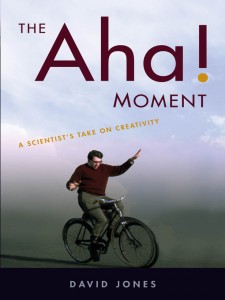
We all dream of being the next Steve Jobs of our field, the one who revolutionizes the industry with a brilliant idea that changes the world. Musicians compose in hopes of becoming as commonly known a name as Beethoven; authors look to Hemingway and Fitzgerald for inspiration for their own works. Regardless of whether we aspire to be the next Picasso or Armani, we all look to “the Greats” with slack-jawed wonder, each of us longing to achieve the crown jewel of human thought: a creative idea. So where do these ideas come from?
A retired chemist best known for his columns as the comical Daedalus in the New Scientist and Nature, David Jones describes his theory of creativity in his recent book The Aha! Moment: A Scientist’s Take on Creativity. Writing about his own creative journeys in science as well as offering dozens of other scientific examples, Jones shows how we may change our ways of thinking to enhance our creative thoughts.
Jones simplifies the human mental structure into three parts: the Observer-Reasoner in the conscious mind, the Censor in the subconscious mind, and the Random Ideas-Generator (RIG) in the unconscious mind. We have different levels of access to each of the three levels, with full awareness of the Observer-Reasoner, some control over the filter of the Censor, and no controllable contact with the RIG. All of our thoughts, decisions, and ideas depend on the interaction of the three layers, but we can change how strong each of the layers are to enhance our creativity.
Most of The Aha! Moment is spent describing the importance of the RIG, with Jones comparing it to “a pet animal … you can be fond of and pleased with what it gives you.” The RIG is described like a vast, swirling pool of information that is collected and enhanced as you learn, read, and experience more. Like a “pet,” the RIG is always active and plays with this information to combine or generalize into a package that is sent to our conscious minds, the Observer-Reasoner.
Before reaching the Observer-Reasoner, the idea must first pass through the Censor, which strictly tries to oppose whatever the RIG sends “up.” Although the Censor is important to filter out “all sorts of dangerous absurdities and mad possibilities [from] being tossed around” in the RIG, it can also impede creativity. In the case that an idea is able to break through the barrier of the Censor and is not discarded as too illogical by Observer-Reasoner, Jones writes that this is the “aha!” moment that we all crave.
We are able to enhance our creativity by flexing and playing with our RIG and “outwitting” our Censor, though most of his book elaborates on the former. According to Jones, there are two components in the RIG to being creative: (1) amassing a large pool of knowledge and experience through life experiences, reading articles, vigilant curiosity, and constant observation; and (2) encouraging the RIG to play with information and stimulating it to pass up ideas to the Observer-Reasoner. The book perfunctorily encourages us to always carry a paper and pencil to jot down ideas the RIG may send at any moment, to try our hand at different academic fields to give our RIG more challenges to play with, to keep a personal database of documents we find intriguing, and to recognize the power of emotional feelings, sexual tension, and intuition.
In the second half of the book, readers are treated to a long parade of the triumphs and experiments in Jones’ career that he attributes to this mode of creative thinking. Describing the thought processes that led to his accomplishments working with NASA, his study of bicycle stability (which he said he was first inspired to study because of his amazement that he could ride a bicycle even when drunk), and dozens more, Jones hammers home the same message with his many examples: Creativity requires a cross-training kind of thinking in which novel ideas are based on pattern recognition and looking at things in fresh perspectives, not inspired guesswork.
Despite the many original descriptions of the thought processes that led to novel discoveries, The Aha! Moment itself does not provide any extraordinarily novel perspectives on creativity. Although Jones writes about his examples in a playful and light-hearted manner, the sheer number of examples he includes to emphasize his message feel somewhat tiring by the end of the book. Additionally, at some points, the book seems to take the idea of the RIG too far, such as when Jones suggests that a woman’s unconscious mind selects eggs it believes are well-suited for the men in her life.
Nonetheless, The Aha! Moment is an entertaining book filled with intriguing reflections, sincere advice, and playful ideas. Although we may not become the next Steve Jobs or Picasso, Jones lets us enjoy a journey inside his creative mind in hopes that we may branch off onto our own innovative paths.
Rating: 4/5
